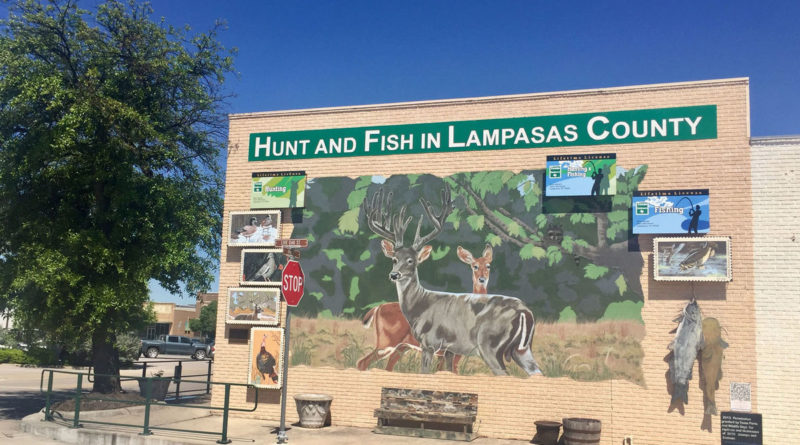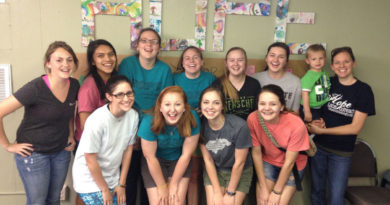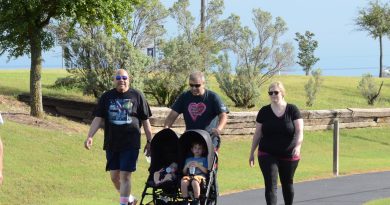Lots to love in Lampasas
Spend a day exploring past, present in small Texas town
The small town of Lampasas contains an interesting history, natural sulphur springs, a nature park, painted murals, a sculpture garden and unique shopping and dining options.
Only half an hour west of Killeen, the calm, quiet town makes for an ideal daylong escape.
Begin your day at the Lampasas County Museum, 303 S. Western Ave., for a history lesson via the museum’s many treasures.
The museum was established in 1978 and is completely volunteer run. All funding comes from fundraising, private donations and grants. The building recently got a makeover, complete with new air conditioning and a skylight that floods light into the many exhibits.
The volunteers enjoy teaching visitors about the artifacts — all of which came to the museum locally — and telling the story of Lampasas.
“We were founded because of our sulphur springs,” Volunteer Carol Wright said of the town. “Native Americans used the waters and the word traveled, more people came here to bathe in and drink the water, then began to build a town.”
The springs are comprised of cold water, and on some days the sulphur smell is still quite strong, Wright said, adding that sulphur is known for its curative powers and was believed to cure everything from sores and fevers to infertility and bad dispositions.
Train transport reached Lampasas in 1882 and the town’s population boom took place at the end of the 19th century and into the early 20th century. At one time, there was even a 200-room luxury hotel in Hancock Park.
The museum contains a detailed miniature of the old hotel, which burned to the ground and is no longer there. They also have a display of old storefront and population signs, various military items such as duffel bags, signed vests from World War II and a quilt made from souvenir pillow tops — many of which say Camp Hood.
There is a display of boots from a revered local bootmaker, a refrigerator in a kitchen set-up from a former Piggly Wiggly and tools from oiling mohair and wool — a big industry in Lampasas at one time.
“The town started with sulphur,” volunteer Amy McDaniel said. “Then wool and mohair was a main industry, then growing cotton. A drought in the 1950s stopped that growth, and Lampasas became a ranching community.”
Visitors can get up close to items such butter churns, ice boxes and washboards — they are not kept behind glass — to get a glimpse at everyday Lampasas life in the past.
The museum will be opening an education center soon, Wright said. It will include a television screen and seats and provide more information on all the exhibits and the county through multimedia.
There is a life-size recreation of the elegant, local First National Bank counter, a sewing and quilting display that represents a skill still popular in the area, an old fortune telling dispenser that used to sit on the square by the courthouse and a collection of toys that belonged to a local girl in the early 1900s.
“One of the dolls is actually wearing a dress that belonged to the girl,” McDaniel said. “Beside it is a picture of her wearing the dress.”
Even the restroom holds county history. An old pharmacy calendar hangs on the wall and there is a display with small tins and boxes from various drugstores that existed in town.
The volunteers are happy to provide visitors with maps and brochures of more things to do when they leave the museum, or offer their opinion on favorite streets for seeing grandeur or historic homes.
“If you want to see a real piece of Texas, this is where you come,” Wright said.
After checking out the museum, spend some time wandering around the town. There are a variety of things to do within walking distance of the museum, depending on your interests. There is a self-guided walking tour brochure and one featuring the location of the town’s murals.
The Vision Lampasas mural project has filled the side of 10 buildings with larger-than-life depictions, including “Water is Life,” “Portraits of the Past,” and “Small Town…Big Sound.” All of them provide fantastic picture opportunities on their own or as a background for a group or family photo.
The Lampasas County Courthouse, completed in 1884, is the third oldest operating courthouse in Texas. There are informative markers surrounding the courthouse that relay stories of both the building and the town.
In beloved classic-small-town-Texas style, rows of historic buildings surround the courthouse square on all four sides. Stores include antique shops, women’s and western wear, florists, an event center and functional businesses such as law and real estate offices.
Newly established store Cork & Press has a selection of Texas wines, olive oils and books that make it hard to find a reason to leave. There’s even a delicatessen inside.
“The books are all from Texas A&M Press and we have every title they have published,” said Cassie Langdon, who is in charge of the deli. “We have Texas wines from four different vineyards and Texas olive oil. Everything is Texas.”
The shop opened last November and must exist a certain number of days before they can serve alcohol by the glass, which is the plan for the near future. They will also host wine tastings on the weekends. For now, you can purchase a bottle of wine and a book (or several) to take home and enjoy at the end of your day-trip.
Next door to Cork & Press is Eve’s Cafe, which serves German dishes, sandwiches and award-winning desserts.
Evelyn Sanchez, who is from a small town in Germany, opened the restaurant in 1995.
“It just keeps getting bigger and bigger,” Sanchez said with a laugh. “Well, the place isn’t getting bigger, but the crowd size sure is.”
She attributes her continued success to making everything fresh.
“Our days start with cutting pork loin, making spaetzle noodles, gravy, broths, salad dressing, cheesecakes, mocha tarts, and everything else fresh and in house,” Sanchez said. “It’s also just laid back. People love to come here because it feels like home. It’s not a franchise, we’re local and we cater to individual needs.”
The interior of the cafe is cozy and whimsical, with puppets attached to the ceiling and quirky posters with German sayings tapped to the walls.
After lunch at Eve’s, head over to Wildflowers on the Wall for ice cream, located on the opposite side of the square. The antique shop is owned by Linda Moore-Lanning, who also owns Cork & Press. An old fashioned soda counter serves treats inside.
“This is part of a vision my mom has,” Meridith Lanning said. “We had a store like this in Phoenix, but mom wanted to get into more unique pieces, one’s you won’t find at every antique store and mall.”
The shop specializes in unique decor and furniture pieces, as opposed to knick knacks.
“The soda shop came about when we were trying to think of what would bring people back in on a regular basis,” Lanning said. “We’re hoping to help Lampasas grow as a destination. There are the springs, art in the park, so many different things. We want to be part of the draw.”
Linda Moore-Lanning researched areas all over Texas before selecting Lampasas.
“Because there are three highways that come together here, she decided this would be a good location,” Lanning said. “She thought the shop was in an ideal place by the courthouse, and squares are a big deal in Texas, you know to go there to look for interesting things.”
After stops at My Girls and The Trading Post — the other antique shops on the square — drive to Hanna Springs Sculpture Garden in Campbell Park for some art in a park, take a swim in Hancock Springs Free Flow Pool, visit the 16-acre Cooper Spring Nature Park, or stroll along WM Brook Park, known as “the Riverwalk of Lampasas” complete with a playground, suspension bridge and outdoor theater. Spend the rest of the afternoon at one of the above parks, or if you’re feeling ambitious, play in several or all of them.
You’ll probably be hungry after hours outdoors, so before you head home, dine at one more local spot for dinner. Molly Lesley with the Lampasas Chamber of Commerce recommended local restaurants for every mood.
Toupsie’s, north of town, specializes in Cajun and Creole food, but is also known for their delicious hamburgers, Lesley said.
“There are three Mexican restaurants, Alfredo’s, El Rodeo and Medina’s,” she said. “Everybody in town has their favorite one, but all have something different to offer. The Twisted Oak Grill just opened up south of town and offers a variety of food. There are also two Italian restaurants, Giovanni’s and Roma’s, both along Key Avenue.”
Depending on when you visit, you’ll be able to see wildflowers.
“The best Bluebonnets are on (Highway) 281 South,” Lesley said. “Though you’ll see them driving in any direction.”
Lesley encouraged visitors to come at any time of year, though, noting the rich history and authenticity of the town to be a rewarding experience.
“I would encourage everyone to go by the museum,” she said. “The people that work there are so knowledgeable. They get excited talking about history, and it excites you in turn. Apart from the historical aspect, people here are just so friendly and there are wonderful places to shop, dine and relax.”




